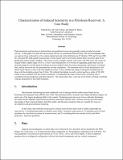Characterization of Induced Seismicity in a Petroleum Reservoir: A Case Study
Author(s)
Sze, Edmond; Toksoz, M. Nafi; Burns, Daniel R.
DownloadSZE.pdf (1.668Mb)
Other Contributors
Massachusetts Institute of Technology. Earth Resources Laboratory
Metadata
Show full item recordAbstract
Fluid production and injection in hydrocarbon and geothermal reservoirs generally results in induced seismic activity. In this paper we study the microseismic activity in a petroleum field in Oman. The microearthquake data we used are those collected by a five-station digital network in the field between 29 October 1999 and 18 June 2001. We relocated 405 high-quality microseismic events using P and S travel-times picked from waveform data by the global grid-search location method. The results reveal a complex seismic zone with a NE-SW trend. All events are located within a depth range of 0.5 to 3.5 km. Focal mechanisms of 10 events of magnitude greater than one are inverted using the wavelet-based waveform inversion method where the source parameters, data kernel, waveform data, and the inversion are all represented by wavelet expansions. The dominant style of focal mechanism is left-lateral strike-slip for events with focal depths less than 1.5 km, and dip-slip along an obliquely trending fault for those with focal depths greater than 2.0 km. The inferred focal plane is nearly vertical and has a strike of NE-SW, which is also consistent with the trend of seismicity. To determine the cause of the events, seismicity rate is correlated with gas production and fluid injection. The results show that event rate in the field is strongly correlated with gas production in the Natih formation.
Date issued
2005Publisher
Massachusetts Institute of Technology. Earth Resources Laboratory
Series/Report no.
Earth Resources Laboratory Industry Consortia Annual Report;2005-01